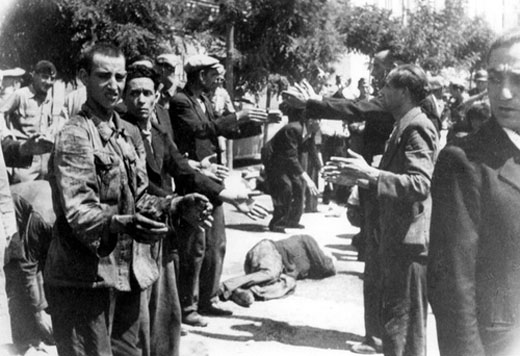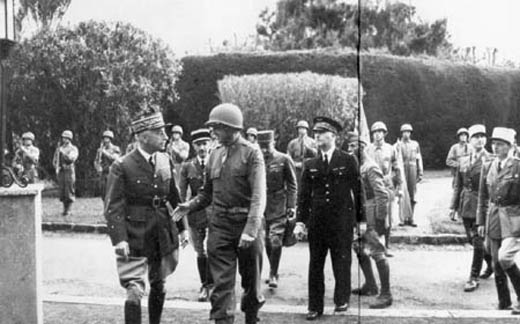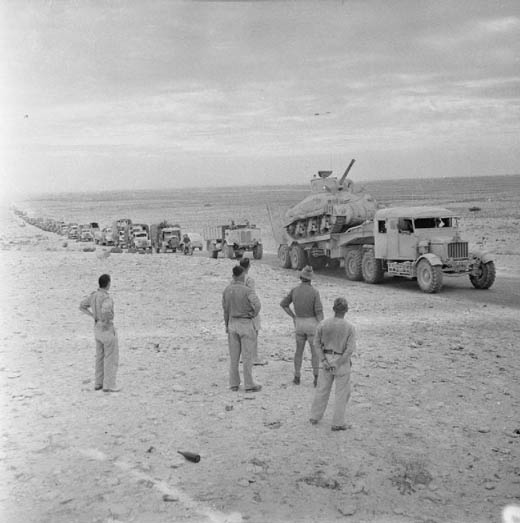Air Operations, CBI
9 10th Air Force P-40s attack Shingbwiyang, Burma.
[Air Operations, Egypt
57th Fight Group P-40s down 8 Axis aircraft in two separate engagements.
[Air Operations, Europe
BOMBER COMMANDEvening Ops:
- 31 Wellingtons lay mines to the Biscay ports and the Frisians without a loss.
Air Operations, Mediterranean
USAMEAF B-24s attacking Axis shipping at sea north of the Libyan coast claim 4 direct hits on one vessel.
[Air Operations, New Guinea
- 3rd Light Bomb Group A-20s attack the Wairopi area.
- The 374th Troop Carrier Group airlifts a US Army regimental headquarters from Port Moresby to the new Pogani Advance Airstrip.
Air Operations, Solomons
- At 0930 hours, 9 D3A 'Val' dive-bomber 18 A6M Zeros from the Japanese carrier Hiyo attack US troop transports, cargo ships, and surface escorts off Guadalcanal. One transport is slightly damaged by a near miss. Marine Corps F4Fs down 5 'Vals' and 5 Zeros, but 6 VMF-121 F4Fs and 4 of the pilots are lost. 1 other Zero is shot down by a 347th Fighter Group P-39.
- At 1100 hours, 25 G4M 'Betty' bombers and 26 A6M Zeros attempting to attack Henderson Field are intercepted by 17 Marine Corps F4Fs. 7 'Bettys' and 1 Zero are shot down. 1 F4F is lost, but its pilot is rescued. Also, a 347th Fighter Group P-39 downs a 'Betty'.
- V Bomber Command B-17s attack shipping off southern Bougainville.
Atlantic
The British submarine Unbeaten is sunk in error by British aircraft in the Bay of Biscay. All 36 of her crew are lost.
[Axis Diplomacy
Germany announces that she will respect Spanish neutrality despite developments in southern France, but Hitler has previously ordered contingency planning for the occupation of Spain.
[Battle of the Atlantic
- All available U-boats, 25, are withdrawn for the north Atlantic an formed into 2 groups: Schagetot, 'Bully', and Westwall off Morocco and Gibraltar for operations against Allied Task Forces in Operation TORCH. 10 transports are sunk, 1 transport and 1 tanker damaged, 1 carrier and depot ship sunk. The Germans lose 1 U-boat with 8 others being damaged.
- The German submarine U-173 torpedoes and sinks the US transport Joseph Hewes (AP-50) (9359t) and torpedoes the destroyer Hambleton (DD-455) and oiler Winooski (AO-38) off Fedala Roads, North Africa.
Eastern Front
In Stalingrad von Paulus' last major attack begins. The Germans make another attempt to eliminate the Russian bridgehead on the river bank in the city center. Squads of assault engineers crawl through sewers and tunnels while tanks attempt to traverse shattered rubble-clogged streets. There is, as usual, vicious fighting with heavy casualties on both sides. Despite some new German tactics the Soviets are able to fragment the German effort so that within two days all central control is lost and the offensive degenerates into a series of unconnected actions. Some German groups are able to penetrate to the Volga while others are cut off from support. The German command is unable to follow the course of the battle and thus the Soviet small-unit expertise gradually prevails. The offensive continues for six days. The Soviets are having problems because floating blocks of ice on the Volga are making the river crossing almost impossible.
SOUTHERN USSRThe German 6th Army commences its final offensive at Stalingrad, preceded by artillery and air strikes. It succeeds in taking most of the Red October factory and isolating the Soviet 138th Div south of the Barrikady factory. By the evening, the 62nd Army occupies three small pockets along the Volga: in the north 1,000 troops at Rynok and Spartakovka; in the center 500 troops near the Barrikady factory; and in the south 45,000 troops and 20 tanks.[MORE]
[France
In Operation ANTON Hitler orders German troops to move into Vichy. German troops enter Unoccupied France, taking possession of Vichy, Limoges, Lyons and several other places. Pétain broadcasts on the radio his official protest against the German invasion of Vichy France: 'I have tonight received a letter from the Führer telling me that, on necessary military grounds, he is forced to take certain steps which will result in the suppression of the agreements and the actual fundamental terms of the armistice. I protest formally against these decisions, which are incompatible with the terms of the armistice.'
The Italians seize Corsica.
[French North Africa
The French authorities sign an armistice with the Allies and all resistance by Vichy troops ceases at 7:00a.m. Half an hour later the American 3rd Inf Div, which would have had to take Casablanca by assault, enters the city amid popular enthusiam. The various military installations are taken over by Allied troops. The British 11th Bde begins to move east from Algiers in strength and the 36th Bde of the British 1st Army lands at (???) is taken without meeting any resistance. The 11th Bde of the 78th Div moves from Algiers towards Bône. These forward forces have little air cover and several of the ships at Bougie carrying important equipment are sunk by the Luftwaffe during the next few days. The Germans now have over 1,000 troops in Tunisia.
[ Greek Jews to Register for Forced Labor |
 |
Indian Ocean
Two Japanese merchant raiders attack the Indian minesweeper Bengal and the armed tanker Ondina in the Indian Ocean southwest of Cocos Island. In the ensuing action Bengal sinks the Hokoku Maru and drives the Aikoku Maruoff despite an enormous disparity of force. Both Japanese ships have 6 6-inch guns, while the Bengalhas 1 3-inch and the Ondina 1 4-inch. The Bengal escorts the Ordina to Fremantle. This action ranks with that of the Stephen Hopkins as one of the most remarkable defenses made by small ships during the war.
[Mediterranean
The troopship Viceroy of India is sunk by U-407 off the north African coast.
[New Guinea
The disease-ravaged and exhausted Japanese suffer another defeat on Papua, losing 600 men in an Australian flanking action at the town of Oivi. The advancing Australians are heavily engaged around Gorari during the next 3 days. When the Japanese finally manage to pull back across the Kumusi River they leave behind 60 dead. Gen Horii is drowned during the retreat. This battle signals the collapse of organized Japanese resistance outside their beachhead at Gona and Buna.
[North Africa
ALGERIAThe British 1st Army lands elements of the 37th Brigade, 78th Div, at Bougie, 110 miles east of Algiers, without opposition. Hart Force, a mobile task force based on the 11th Brigade, 78th Div, moves out of Algiers toward Bône, traveling overland.
MOROCCOThe Western Task Force cancels its attack on Casablanca because of the armistice. The 3rd Div enters the city at 0730. Combat Command B, 2nd Armored Div, receives the surrender of Mazagan and establishes a bridgehead at Azemmour without opposition. Enemy torpedoes sink a US transport off the coast.
General Nogues Arriving at Fedala |
 |
The X Corps of the British 8th Army, still following up the retreating Axis forces, enters Libya and occupies Bardia without a shot fired. The 1st and 7th Arm Divs are on the heels of the Axis rearguards in Libya. The 2nd New Zealand Div halts on the Libyan-Egyptian border to reorganize.
Sherman on a Tank Transporter |
 |
Guadalcanal
At 0530 the 3 transports (Zeilin, Libra, Betelgeuse) begin unloading but are interrupted twice during the day by enemy bombers which damage all 3 ships. The transports retire at 1800 to Indispensable Strait. The damage to the Zeilin is serious and it is escorted by destroyer back to Espiritu Santo. A naval force bringing reinforcements and supplies from New Hebrides arrives and begins unloading. When 3 transports of the force are damaged by enemy aircraft, the group retires to join naval forces approaching New Caledonia.
Japanese carriers send 10 dive bombers and 12 Zeros to attack Henderson Field. F4Fs go up to intercept. They claim 5 Zeros and 1 bomber with 2 Zeros and 1 bomber as 'probables'.
The westward offensive toward Kolumbona is halted bacause of strong indications that the enemy may attempt to recover the Lunga area. After reaching positions a little beyond those gained on November 4, the assault force begins to withdraw across the Matanikau. East of the Lunga perimeter, the 2nd Battalion, 164th Infantry, closes a gap on the southern flank of the US line about the enemy along Gavaga Creek and drives north toward the beach while the 7th Marines closes in from the east and west. The Japanese are determined to prevent the Americans from taking Kokumbona, the site of the 17th Army command post and one end of the main supply trail to positions the Japanese were preparing on Mount Austen. The defense of the village is assigned to Maj-Gen Takeo Ito, Infantry Group Commander, 38th Division. He had landed November 5th and took command of a reserve force of 5,000 men. In an effort to outflank the Americans, he takes his force into the jungled hills on left flank of Americans 5,000 yards south of the beach. Before he could launch, the Americans, unaware he was there, receive word the Japanese are preparing to bring large troop convoys to Guadalcanal in mid-November. To meet the threat of another counteroffensive, all troops are needed within Lunga perimeter. The American battalions disengage. The 2nd and 8th Marines pull back toward the Matanikau covered by the 1st Battalion, 164th Infantry.
[Pacific
The US submarine Haddock (SS-231) sinks the Japanese merchant carog ship Venice Maru (6571t) in the center of the Yellow Sea, between China and Korea.
[